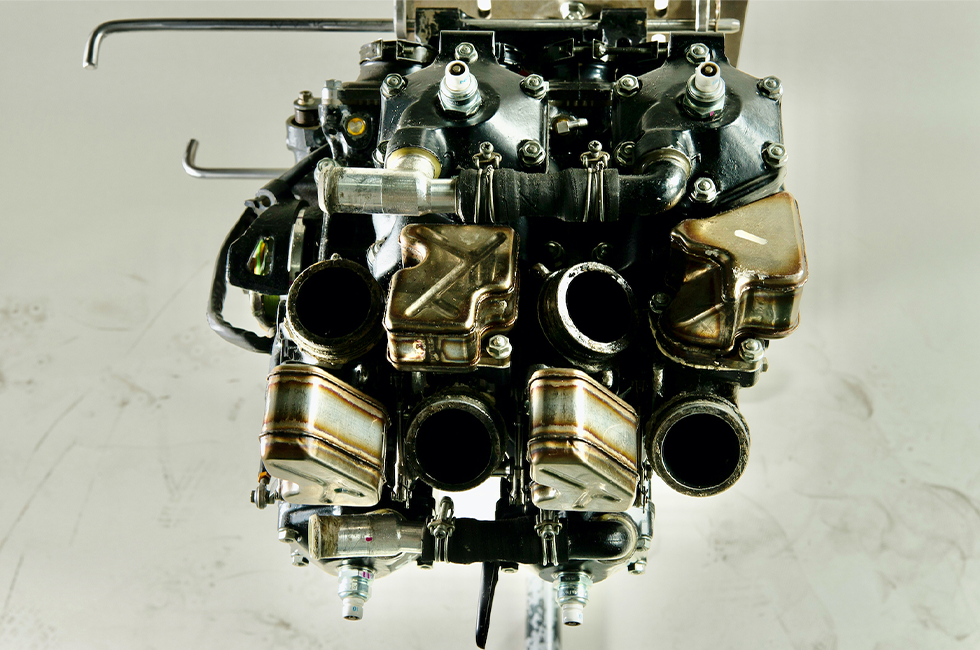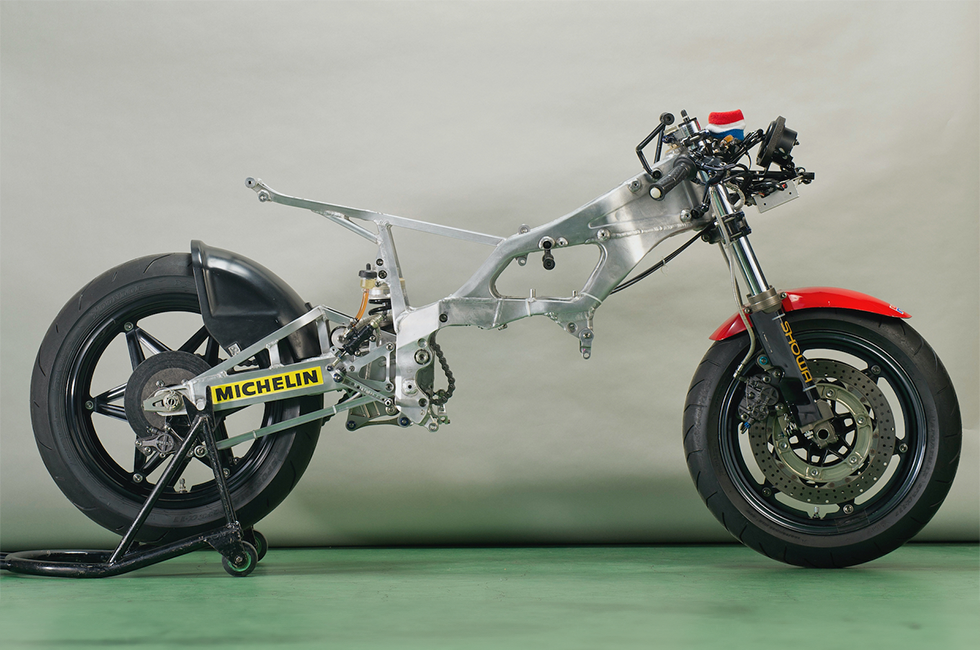1984 NSR500 Technical Specifications
text=KIYOKAZU IMAI
translation:SHINTARO URASHIMA
Original Upside-down Layout
The First Generation NSR500 With a One-And-Only Body Configuration

1984 NSR500 [NV0A] (Photo/Yoshihiro Ishizuka)

The NSR500's V4 engine has been removed from the chassis (the left side). Its V-bank angle is 90 degrees, with the rear cylinder standing vertically and the front cylinder lying horizontally. All the photos posted in this chapter were taken in 2010 when the NV0A housed in the Honda Collection Hall was disassembled and checked.
"A 3-cylinder engine may have been fine initially, but it should have a 4-cylinder engine. By the regulations, we should have pursued the number of cylinders and displacement at the very limit," said Takeo Fukui in an interview after his retirement as President and Representative Director of Honda Motor Co., Ltd., which he had served from June 2003 to June 2009. Around the fall of 1982, HRC began serious consideration of a new 4-cylinder 2-stroke GP500 road racer. Fukui was in charge of the development and racing operations at HRC.
HRC's main focus in developing the NSR500 was to enable it to fight with greater power. While the displacement per cylinder is 166.2cc for the NS500's 3-cylinder engine, it is 125cc with a 4-cylinder 500cc engine, which makes it easier to increase the peak rpm. Higher rotations lead to higher maximum output. Other expectations were that by adopting a 4-cylinder engine, the problems that the NS500 had, such as the amount of vibration and the tendency for the cylinder and piston to seize due to the size of the bore, could be reduced.
Its cylinder bore is 54mm, and piston stroke is 54.5mm. The displacement per cylinder is 124.8cc; if you add up the four cylinders, it becomes 499.2cc, close to the 500cc displacement limit.
The bore stroke of the NS500 was 62.6mm x 54.0mm, which was based on the design of a motocrosser engine with a reasonably short stroke for a road racing engine. On the other hand, the 4-cylinder NSR500 had a bore stroke ratio of approximately 1:1 to obtain engine characteristics that ensured thicker mid-speed torque.
The intake system featured a crankcase reed valve. The mainstream at the time was the rotary disc valve, but the reed valve system had better flexibility in engine output in the medium to the low-speed range. They could also find an advantage at the push start, which was usual in the WGP road racing at the time. Honda used a reed valve system in the previous generation NS500, but more accurately, it was a piston reed valve. On the other hand, for the NSR500, they chose a crankcase reed valve with minor fluctuations in intake pressure due to engine speed.

This photo shows the engine alone, looking down from the front. The direction of the exhaust port is different for each cylinder, and it is clear that it took a lot of effort to maneuver the four exhaust chambers into the narrow space above the engine. The silver box-shaped part is the sub-chamber of ATAC (Auto controlled Torque Amplification Chamber) that increases torque in the low and medium speed range. The inlet valve opens and closes depending on the engine speed.
The layout of the 4-cylinder engine was V-shaped with two cylinders placed at the front and rear, and the angle between the front and rear cylinders was set at 90 degrees. The primary vibrations were canceled by creating evenly spaced explosions, in which ignition occurred in four cylinders at equal intervals with a crank rotation angle of 90 degrees.
The crankshaft was a single-axle type driven by four connecting rods. All rival racers at the time had two-axle cranks, while single-axle cranks had the disadvantage of requiring more width and making the crank challenging to manufacture. HRC overcame it and made it happen with a lot of help from partner companies. The result was a reasonably sturdy but light and compact engine. The engine weight of the NSR500, NV0A, was 40.5kg, which was only about 1.5kg heavier than the NS500, even though it had one more cylinder.
Bore 54mm x stroke 54.5mm, crankcase reed valve intake, single-axle crankshaft, these specifications, which determined the engine's potency, were adopted in all subsequent NSR500 series. The NSR500 competed in the World Grand Prix for 19 years, and the V4 engine of the first model, NV0A, was its very origin.
The maximum output of the NV0A was 141.8ps/11,000rpm before the start of the 1984 season. The previous generation NS500's final race specification in 1983 was 131.4ps/11,000rpm, so it was almost ten horsepower higher. As tuning progressed during the season, the final race spec of the NV0A in 1984 produced a maximum output of 145.4ps/11,500rpm and a maximum torque of 9.2kg-m/11,000rpm.

The NV0A used an aluminum frame made by welding press-formed parts, which is rare among successor NSR500 models. The idea behind the chassis is a twin-spar frame that connects the steering head and swing arm pivot in a straight line, which becomes apparent when you remove the engine and other parts and expose it completely.
When you face the NV0A with all the cowls removed, your eyes are drawn to the four exhaust chambers that fit where the fuel tank would be in a standard layout and the fuel tank that ordinarily fills that space is under the engine. By removing everything, including the motor, and just leaving the chassis, this is when you can recognize that the NVOA frame body has a unique shape.
That is what the twin-spar frame concept is all about. A girder section that separates from the steering head to the left and right connects straight to the swing arm pivot. The center of the girder section is divided into upper and lower parts shaped to accommodate the need to hang the fuel tank under the engine.
The girder part is made by combining press-molded pieces of aluminum plates. The NV0A was the first time Honda produced a competition motorcycle with a frame made using this method. However, the first-generation NR500 used a monocoque body. Conventionally, Honda's road racer frames had only been made of round steel pipes or square aluminum pipes. In addition, starting with the second generation NSR500 model, NV0B, the frame continued to be made of extruded aluminum square pipe with a cross-section with one or two ribs inside. In other words, the frame of the first model, NV0A, adopted a rare manufacturing method and shaped frame design for successive NSR500s.
This was also the first time an HRC road racer adopted a twin-spar frame configuration. At that time, HRC was researching a frame that was lightweight, highly rigid, had a deep lean angle, and had a high degree of freedom in the layout of the engine, etc. The ULF (Ultra Light Frame) was the name of the project.
Compared to the final aluminum square pipe double cradle frame the NS500 used, this NV0A's fantastic twin-spar frame improved torsional rigidity by 18% and lateral bending rigidity by 73%. Overall, the rigidity was increased by 34%.






